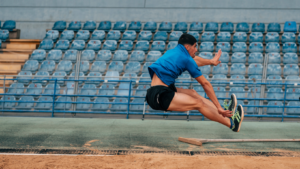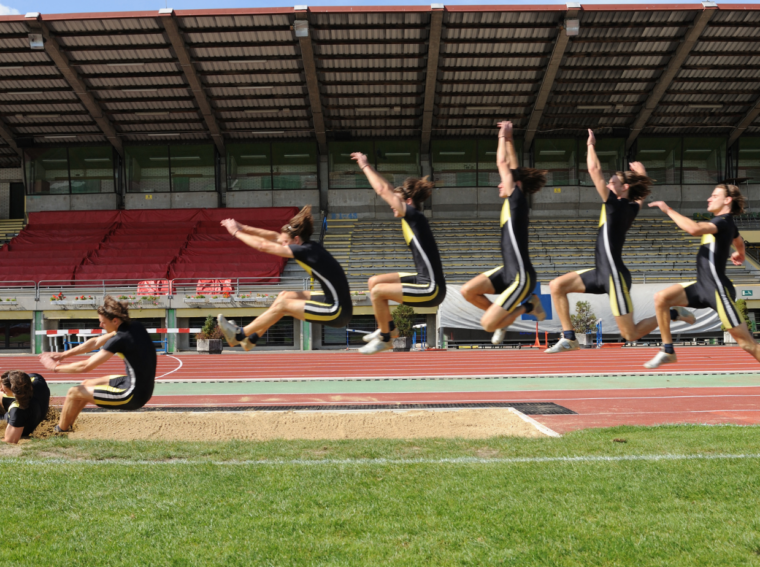Diving into the world of athletics, one can’t help but be fascinated by the sheer power and precision involved in long jump. A critical component that often gets overlooked is the jarak awalan lompat jauh adalah or the run-up distance in long jump. It’s the heartbeat of the jump, setting the rhythm and pace for the athlete’s flight.
This jarak awalan lompat jauh adalah isn’t just about speed; it’s a delicate balance of velocity, angle, and technique. Too short, and the jumper may not gain enough momentum. Too long, and they might lose control. Understanding and mastering this aspect can significantly improve an athlete’s performance.
Jarak Awalan Lompat Jauh Adalah
 Long jump, as an athletics discipline, holds fascination, combining speed, strength, and agility. It centers on two key actions: the approach run and the jump itself. Emphasizing an approach run’s importance, a top-quality run-up significantly enhances the chances of a momentous jump. Providing a strong initial momentum, athletes harness this speed, transforming it into the lift required for a long jump. Statistics indicate that a 1% increase in speed can result in a significant 2.7% improvement in jump distance – a testament to the approach run’s vital role.
Long jump, as an athletics discipline, holds fascination, combining speed, strength, and agility. It centers on two key actions: the approach run and the jump itself. Emphasizing an approach run’s importance, a top-quality run-up significantly enhances the chances of a momentous jump. Providing a strong initial momentum, athletes harness this speed, transforming it into the lift required for a long jump. Statistics indicate that a 1% increase in speed can result in a significant 2.7% improvement in jump distance – a testament to the approach run’s vital role.
Indonesian Approach to Long Jump: Jarak Awalan Lompat Jauh Adalah
 Jarak Awalan Lompat Jauh Adalah translates as “the run-up distance in long jump” is a pivotal part of Indonesian athletics coaching techniques. This approach recognizes the indispensable role of the apposite run-up length for ensuring an efficient, impactful long jump.
Jarak Awalan Lompat Jauh Adalah translates as “the run-up distance in long jump” is a pivotal part of Indonesian athletics coaching techniques. This approach recognizes the indispensable role of the apposite run-up length for ensuring an efficient, impactful long jump.
Different athletes might prefer different jarak awalan lompat jauh adalah, usually in the bracket of 12-45 strides. The choice fundamentally depends on the athlete’s level of comfort, speed, and their capability to maintain rhythm and balance, critical for launching a successful long jump.
The Significance of Jarak Awalan Lompat Jauh Adalah in Long Jump
The jarak awalan lompat jauh adalah plays a critical role in long jumping. It’s the launching pad for the athlete, a determinant of the momentum they’ll carry into the leap. It’s a crucial factor in not only securing a successful jump but also to protect the athlete from potential injuries.
How to Calculate the Optimal Run-up Distance
 Calculation of the optimal jarak awalan lompat jauh adalah remains a judicious combination of physics and individual uniqueness. Coaches consider several components for this process. Athlete’s comfort, natural stride length, speed capacity, and rhythm pattern serve as a starting point.
Calculation of the optimal jarak awalan lompat jauh adalah remains a judicious combination of physics and individual uniqueness. Coaches consider several components for this process. Athlete’s comfort, natural stride length, speed capacity, and rhythm pattern serve as a starting point.
-
Identifying max speed: An athlete’s maximum speed provides a key indicator. They, generally, hit their peak speed within approximately 20-35 strides. However, sustaining the speed is vital. If the speed drops before take-off, it decreases the jump’s effectiveness.
-
Stride length and frequency: Coaches incorporate an athlete’s stride length and frequency to establish the jarak awalan lompat jauh adalah. Shorter athletes might take a higher number of shorter, quicker strides and vice versa for the taller athletes.
-
Consistency: One size doesn’t fit all in athletics. It’s about individual customization. The jarak awalan lompat jauh adalah differs from athlete to athlete, emphasizing repeatability and consistency in maintaining the optimized stride pattern.
The Science Behind the Ideal Jarak Awalan Lompat Jauh Adalah
Analyzing the science offers further insights. The direction of motion and the force of the jump are two influencers of a successful long jump. The momentum generated from the run-up has to transition into the jump. But, it must happen within the laws of physics.
-
Conversion of horizontal to vertical motion: The challenge lies in this transition phase. The athlete must convert horizontal momentum into vertical propulsion using a technique known as “blocking.” It’s the process of planting the foot just before the leap, stiffening the leg, and using it as a pivot, redirecting forward momentum upwards.
-
Angle of projection: Another aspect is the angle of projection at take-off. An angle too steep, the athlete might achieve a high jump but compromise on the distance. If it’s too flat, the distance might increase, but the overall height of the jump might be low. The sweet spot lies typically around 20-22 degrees.
Need To Know About Jarak Awalan Lompat Jauh Adalah
Perfecting the long jump is no small feat. It’s a delicate balance of speed, strength, and technique. By focusing on the jarak awalan lompat jauh adalah, athletes can significantly enhance their performance. Training exercises like squats and plyometrics can help build the necessary lower body strength. Yet, it’s the attention to body mechanics and the optimal take-off angle that can truly make the difference. Personalized training, tailored to an athlete’s unique strengths and progress, can guide them towards their best possible performance. So, while the long jump may be complex, with the right approach to the jarak awalan lompat jauh adalah, it becomes a challenge that’s not just achievable but also rewarding.
